Master Comparison Page
|
Topics: |
Using the Master Comparison page, you can compare instance records with golden records, and other instance records.
To access the Master Comparison page for a golden record, click the Master Comparison link for the appropriate record on the Home page or Search Results page.
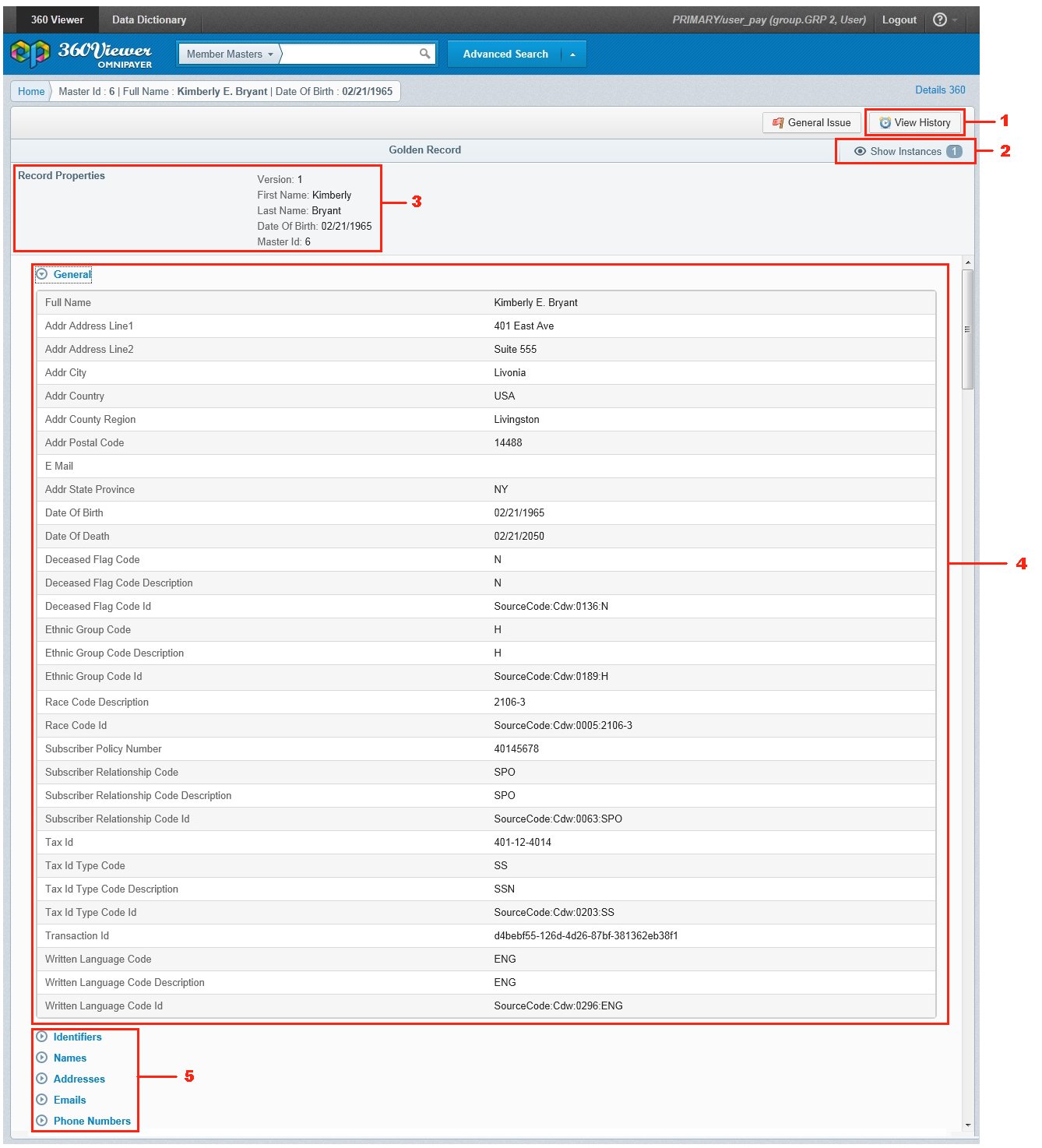
The Master Comparison page contains the following areas:
- View History button. Allows you to view a list of versions for the golden record.
- Show Instances link. Expands the instance records section.
- Record Properties section.
- Grouped attribute section(s).
- Subdomain(s) section(s).
The Record Properties section includes the version number, record ID, and the last modified date on the top of the page and can be configured using the Admin Console. For more information, see Using the Admin Console.
By default, only golden record data is displayed on the Master Comparison page.
The data is organized into sections that can be configured using the Admin Console. For more information, see Using the Admin Console.
The collection of items, which represent subdomain data, are displayed hierarchically in expandable sections (collapsed by default) and can also be configured using the Admin Console. For more information, see Using the Admin Console.
To view all instance records that correspond to the current golden record selected, click the Show Instances link. This link displays the number of instance records for the golden record. When you click this link, the candidate section is expanded to the right of the golden record.
For easy comparison, the information for the instance records is displayed next to the golden record. Attribute values in each instance record that are different from the attribute values in the golden record are highlighted in pink. The values that are common (standardized) to both records (golden and instance) are highlighted in yellow.
The Record Properties section for instance records displays the Source Name, Source Instance ID, and the last modified date. The properties for this view can be configured using the Admin Console. For more information, see Using the Admin Console.
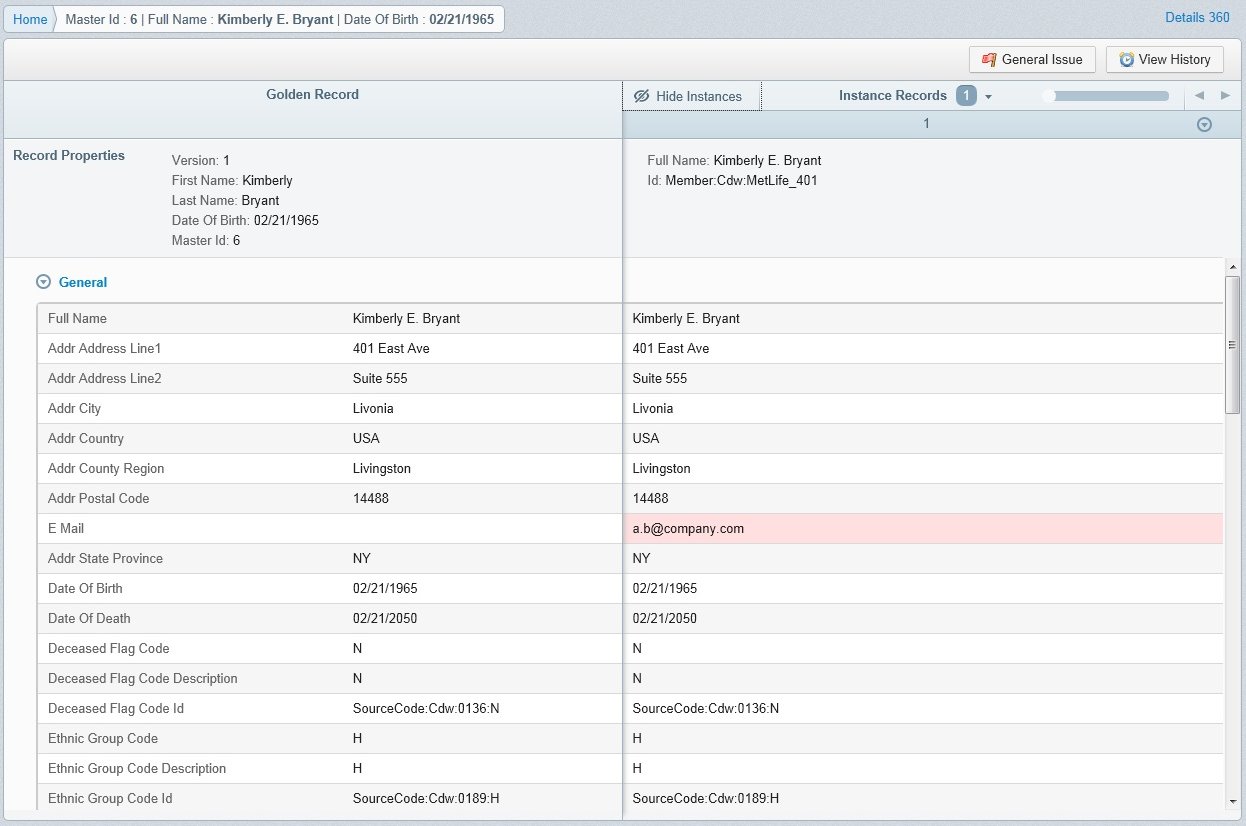
Subdomains are essential attributes of a golden record that are not uniquely identified in the record. Subdomains are almost always a many-to-one relationship with the base record. These subdomains could include names, addresses, and contact information (for example, email addresses, phone numbers, and so on). However, one instance record may have two names in a collection, and another instance may have three. The resulting golden record may be a union of values across instance records.
Instance records could have a different number of items in their collections and not all items are used to compose the golden record. The items that are used in a golden record are highlighted with a green border. Values of attributes in each instance record that are different from the attribute value in the golden record itself are highlighted in pink. The values that are common (standardized) to both records (golden and instance) are highlighted in yellow.
Using the Instance Records Overlay Window
The Instance Records overlay window contains the following areas:
- Simple Search input.
- Advanced Search link. Opens the Advanced Search page.
- List of Instance records. Shows all instances or search results.
- Done button. Closes the dialog and displays only the selected instance records on the Master Comparison page.

When there are many instance records corresponding to the current golden record, you can open the full list of instance records and select some records to be displayed in Comparison mode. You can also search the desired instance record by performing a simple search or leveraging the advanced search by using all of the attributes that are available.
When you click on the title of the instance records section, you receive a list of all instance records corresponding to the current golden record. All the records in the list are selected by default. If the list long, then a scrollbar inside the overlay window is included. For each instance record, the Source Name, Source Instance ID, and the last modified date are displayed. The fields that are displayed can be configured using the Admin Console. For more information, see Using the Admin Console.
Currently displayed records are selected and highlighted. To select or deselect records, select or deselect the appropriate check boxes. When you are finished with your selections, click Done to close the overlay window and refresh the Comparison view to show the selected instance records.

Performing Simple Searches for Instance Records
You can perform a simple or advanced search to narrow the list of instance records. This search mechanism is similar to the search of golden records. However, there is no validation of minimum alphanumeric characters performed for a simple search. Wildcard searches are also supported. A scope of the search is defined by the currently displayed golden record.
Performing Advanced Searches for Instance Records
To search by different parameters (for example, to find all instance records that have a particular DOB, the same as in the golden record), you can leverage the advanced search. When you click Advanced Search, the overlay window is enlarged. You can enter any number of search criteria and then click Search.
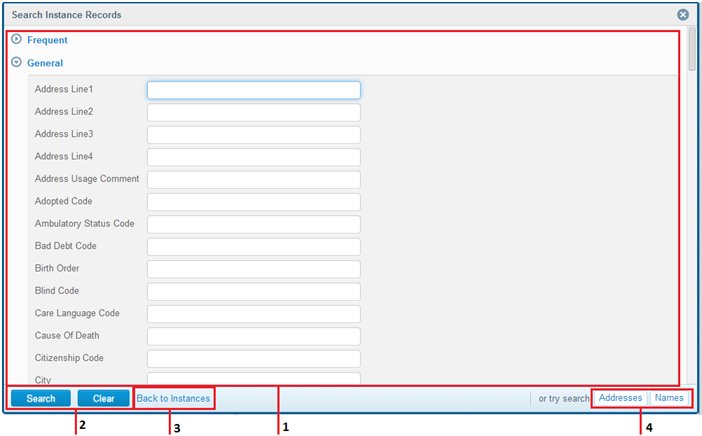
The Advanced Search page contains the following areas:
- Grouped attribute areas. Used to set search parameters.
- Search and Clear buttons.
- Back to Instances link.
- Subdomain links. Allow you to search by subdomain record parameters. The list of displayed subdomains can be configured in the Admin Console. For more information, see Using the Admin Console.
The attributes in the Advanced Search dialog are grouped into sections to make it easier for you to find the necessary attribute. This can be configured using the Admin Console. For more information, see Using the Admin Console. Only one section can be expanded at once. When another section header is clicked, the new section is opened and the previously opened one is closed.
After the Search button is clicked, the list of search results, which consists of matching instance records corresponding to the current golden record, is displayed.
The Clear button deletes all entered criteria, except for the value in the Keyword field. The value in the Keyword field can be only cleared manually.
After the Back to Instances link is clicked, the Advanced Search dialog is closed and the instance records overlay window is displayed.
When an advanced search is used to refine simple search results, the Keyword attribute is populated with the value entered in the Simple Search input field. The final query is combined with the Keyword search and additional attributes.
If you edit the formerly filled in Keyword field and perform an advanced search, the value in the Simple Search input field is overwritten with the new value.
If you already received advanced search results and return to the search overlay to edit search criteria, the values that you entered in your previous query are preserved.
There is a validation mechanism for numeric fields and fields with date format. It works for domain and subdomain pages.
After invalid data is entered and you click Search, an appropriate message is displayed and the corresponding field is highlighted in red, as shown in the following image.

When you want to perform an advanced search by subdomain, click the appropriate subdomain link and the search overlay is populated with fields. These fields can be configured using the Admin Console for a specific subdomain. For more information, see Using the Admin Console.
Every subdomain page includes a Return to <name_of_domain> button, that allows you to return to the search results by domain, as shown in the following image.

Viewing the Search Results Page for Instance Records
After a simple search was performed using existing criteria, the resulting rows are displayed, as shown in the following image.
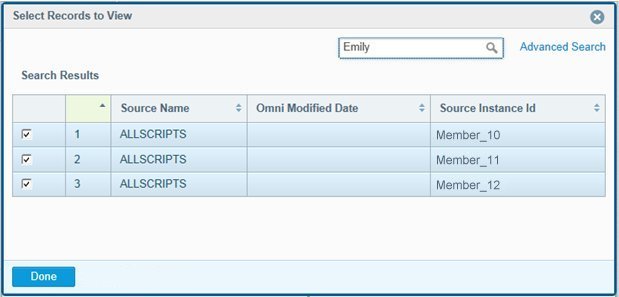
All of the records are selected by default.
For the Advanced Search results page, the search query parameters are summarized above the search results, as shown in the following image.
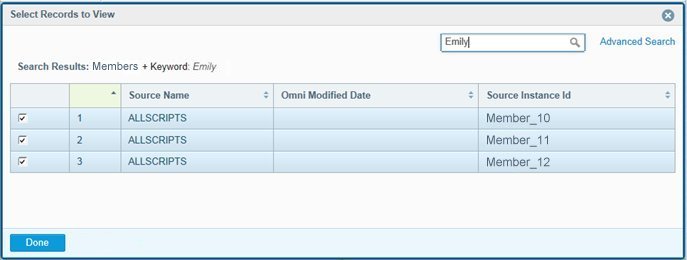
When you perform a search using invalid search criteria, an appropriate message is displayed on the Search results page, as shown in the following image.
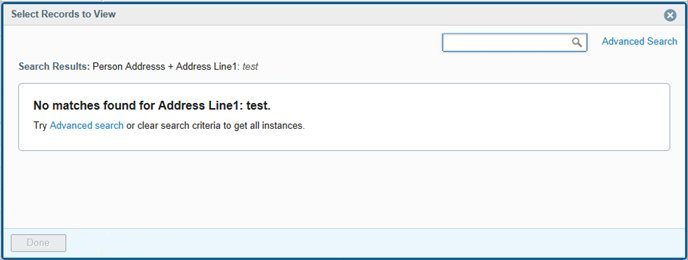
You can navigate to the Advanced Search dialog by clicking the Advanced Search link or go back to the full list of instances if you click Done.